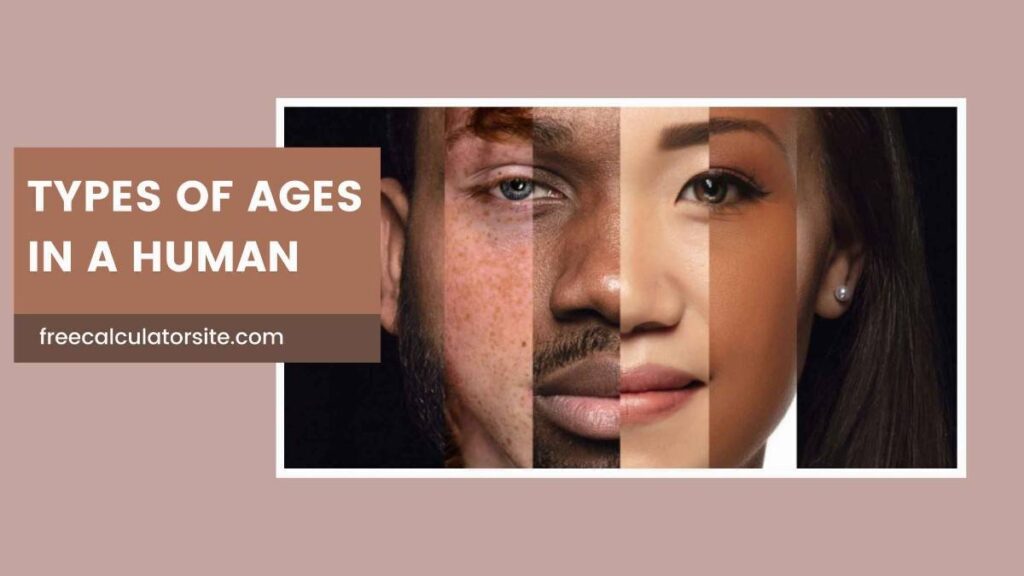Last updated on October 1st, 2024 at 11:01 pm

Human development is a complex and multifaceted journey, and age isn’t just about the number of years you’ve lived.
Various types of “ages” describe different aspects of growth, maturity, and experiences, providing a fuller picture of how we develop over time.
This article explores the ten primary types of ages, explaining their unique characteristics, applications, and significance in our lives.
1. Chronological Age
Chronological age is the simplest and most commonly used type of age.
It refers to the exact amount of time that has passed since a person was born, measured in years, months, and days.
Usage
This is the age we use most frequently in everyday life—whether it’s celebrating birthdays, filling out forms, or determining eligibility for certain activities.
Chronological age serves as the standard for determining legal rights, responsibilities, and societal roles. For instance:
- At 18, one reaches the legal age of adulthood in many countries.
- At 21, people gain the legal right to consume alcohol in some regions.
Limitations
While chronological age is straightforward, it doesn’t necessarily reflect an individual’s physical, mental, or emotional development.
For example, two people of the same chronological age may have vastly different levels of health, intelligence, or maturity.
2. Biological Age
Biological age refers to how old a person seems biologically in comparison to their chronological age.
It reflects the condition of an individual’s body and how well or poorly it functions.
Usage
Biological age provides a more accurate picture of one’s health and vitality.
Factors such as genetics, lifestyle, diet, exercise, and exposure to stressors influence biological age.
For example, someone who follows a healthy diet, exercises regularly, and avoids smoking might have a biological age that is younger than their chronological age.
Significance
Understanding biological age is crucial for health and wellness.
It’s widely used in medical research, anti-aging studies, and fitness assessments.
Knowing one’s biological age helps individuals make informed lifestyle choices, as it highlights how their habits and environment affect their body’s aging process.
Also Read: Differences Between Chronological and Biological Age
3. Developmental Age
Developmental age measures a person’s physical, cognitive, and emotional growth compared to average developmental milestones.
It’s often used to assess children’s progress in terms of physical abilities, language skills, social interactions, and cognitive understanding.
Usage
In pediatrics and psychology, developmental age is vital for identifying whether children are developing at an expected rate.
It can help detect developmental delays, learning disabilities, or areas where a child may excel. For example:
- A three-year-old who can speak in full sentences might have a developmental age higher than their chronological age.
- Conversely, a child who struggles with speech at the age of three may have a lower developmental age.
Importance
Assessing developmental age allows for early interventions and support, ensuring children receive the necessary resources to thrive.
It also helps parents and educators tailor activities and learning experiences to suit each child’s unique needs.
See Also: Chronological Age vs. Developmental Age
4. Mental Age
Mental age represents the level of intellectual functioning or cognitive ability, regardless of a person’s chronological age.
It’s an indicator of how one’s mental capabilities compare to the average abilities of others at different ages.
Usage
Psychologists and educators frequently use mental age to assess intellectual development, particularly in children.
This concept is essential in understanding learning abilities, intelligence quotient (IQ), and potential educational needs.
For example:
- A 10-year-old child who demonstrates reasoning skills typical of a 12-year-old has a mental age of 12.
- Someone with a learning disability may have a mental age significantly different from their chronological age.
Applications
Mental age is a critical factor in diagnosing intellectual disabilities, giftedness, and other cognitive differences.
It helps create individualized learning plans that cater to a person’s intellectual strengths and challenges.
Also Read: Chronological Age vs Mental Age
5. Gestational Age
Gestational age refers to the age of a pregnancy, calculated from the first day of the mother’s last menstrual period.
It’s measured in weeks and provides an estimate of the fetus’s development inside the womb.
Usage
Gestational age is essential in obstetrics for monitoring fetal growth and development.
It helps healthcare professionals assess whether a baby is developing appropriately and aids in determining the due date.
A full-term pregnancy typically lasts about 40 weeks.
Significance
Understanding gestational age is crucial for identifying potential complications, such as preterm birth or delayed growth.
It allows doctors to provide appropriate care and interventions to ensure the health and safety of both the mother and baby.
See Also: Chronological Age vs. Gestational Age
6. Emotional Age
Emotional age indicates how mature a person is in handling emotions, coping with stress, and building relationships.
It reflects an individual’s emotional intelligence and maturity.
Usage
Therapists, counselors, and personal development coaches often explore emotional age to understand a person’s ability to manage feelings, empathize with others, and handle life’s challenges.
For instance:
- A person with a high emotional age might remain calm under pressure and navigate conflicts gracefully.
- Conversely, someone with a low emotional age may struggle to control their emotions or handle criticism.
Importance
Recognizing emotional age can be transformative in personal development, helping individuals work on emotional regulation, communication, and interpersonal skills.
It also plays a significant role in fostering healthy relationships and overall well-being.
7. Social Age
Social age refers to how an individual’s life stages, roles, and responsibilities compare to societal norms.
It encompasses the expectations society has for people at different ages regarding behaviors, achievements, and social roles.
Usage
Social age can be seen in how society expects certain milestones, such as starting school, getting a job, getting married, or retiring, to happen at specific ages.
For example:
- A 30-year-old who is married with children may be considered to have a social age that aligns with societal expectations.
- In contrast, someone who has not followed these traditional paths might be seen as having a different social age.
Significance
Social age helps us understand how societal norms and expectations influence our sense of identity, self-worth, and belonging.
It’s a valuable concept in sociology and cultural studies.
8. Functional Age
Functional age measures an individual’s ability to perform tasks and activities typical of their age group.
It assesses how well someone can manage day-to-day activities, regardless of their chronological age.
Usage
Functional age is commonly used in gerontology (the study of aging) to assess how aging affects a person’s ability to live independently.
It helps determine whether someone requires assistance with activities like cooking, cleaning, or personal care.
Importance
This concept is crucial for designing elder care services, rehabilitation programs, and support systems that help maintain quality of life as people age.
It also highlights the diversity in aging experiences, as not all people of the same chronological age have the same functional abilities.
9. Relative Age
Relative age compares an individual’s age to others in a particular group, such as peers, classmates, or teammates.
It often focuses on how differences in age can impact abilities, performance, or opportunities.
Usage
Relative age is particularly relevant in education and sports.
For example:
- In school, children born early in the academic year might have a developmental advantage over those born later.
- In sports, older athletes in youth leagues may perform better due to more advanced physical development.
Impact
Understanding relative age effects can help create fairer opportunities in education and sports by recognizing how age differences influence performance and development.
10. Real Age
Real age, sometimes called “true age,” is similar to biological age but takes a broader view by incorporating factors like lifestyle, stress levels, medical history, and overall health habits to determine how “old” your body truly feels.
Usage
Health and wellness assessments use real age to provide insights into how one’s lifestyle choices impact their aging process.
For instance, someone who manages stress well, exercises regularly, and eats a balanced diet may have a real age younger than their chronological age.
Benefits
Knowing your real age can be a powerful motivator for adopting healthier habits, as it offers a tangible measure of how lifestyle changes can slow or reverse the effects of aging.
Conclusion
These different “ages” reveal that human development is far more complex than just counting birthdays.
Each type of age offers unique insights into various aspects of our lives—physical health, cognitive abilities, emotional growth, and societal expectations.
By understanding the multiple dimensions of age, we gain a deeper appreciation for how we grow, change, and navigate the journey of life.
Whether it’s nurturing a child’s developmental milestones, adjusting to the challenges of aging, or embracing a healthier lifestyle, recognizing the many facets of age helps us live more fulfilling and informed lives.

Akash Singh is a finance enthusiast who shares valuable insights on various calculators.
